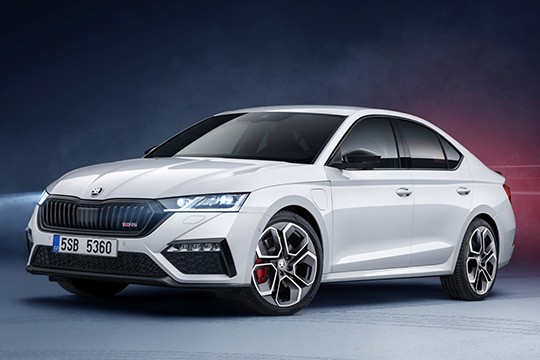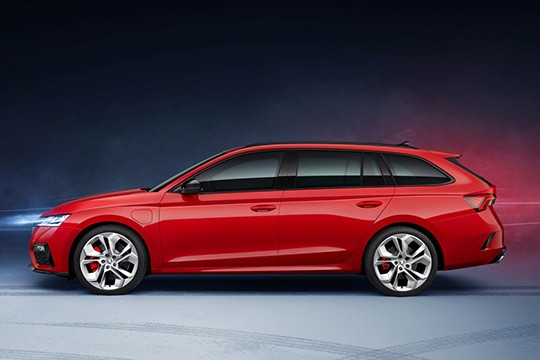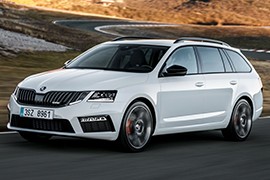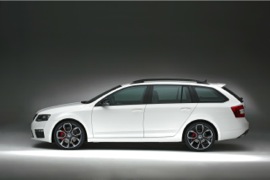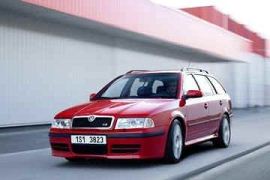SKODA Octavia Combi RS Models/Series Timeline, Specifications & Photos
First production year: 2002
Engines: Mild hybrid, Hybrid, Diesel, Gasoline
Body style: Wagon (station wagon, estate, combi, touring)
The Czech carmaker Skoda just turned its sportiest model towards the electricity avenue with the fourth generation of its performance model, the Octavia vRS. They even called it iV, instead of a simple 4th or IV. And it is not just a hybrid, it is a plug-in hybrid. It is the kind of vehicle that might steer petrolheads towards electric mobility.
The first three generations of the Octavia vRS were mostly gasoline turbocharged engines and it was a cheaper alternative for hot-hatches, but packed into a more practical bodywork. Now it is not that cheap anymore, but it is more practical. Under the hood, Skoda installed a 1.4-liter TSI engine that offers 150 hp. On top of that, an electric motor of 85 kW helps things up obtaining a total combined output of 245 hp and 400 Nm (295 lb-ft) of torque.
Transmission is on the front wheels only via a 6-speed DSG (double-clutch) gearbox. But the performance numbers are not so impressive. Actually, since it is a plug-in hybrid and it is heavier than the previous generation, it is much slower. The 0-100 kph (0-62 mph) sprint is obtained now in 7.3 seconds, compared with 6.8 seconds for the former generation. The top speed now is 225 kph (140 mph), which is 25 kph (15.5 mph) slower than the Octavia vRS from the 3rd generation. But it is more fuel-efficient. If that will count for a petrolhead.
The Czech car manufacturer planned to launch the RS iV version of the Octavia Combi at the 2020 Geneva Motor Show, but when the world went into lockdown, it had to cancel its plans and find another way of showing the vehicle.
In early 2020, Europe was frozen due to the pandemic situation, and all motor shows were canceled. Plans were scrapped, and automakers had to find new solutions to show their latest products. Some of them, such as Skoda, went on to the Internet and pushed hard to get people to see its products, and that’s how the Octavia Combi RS iV appeared in front of potential buyers. Unfortunately, the carmaker’s plant in Mlada Boleslav was also closed, so production could only resume in the summer of 2020. But for the brand’s fans, the wait was worth it since it was the first RS-badged Skoda that sported a plug-in hybrid powerplant.
Skoda had a long connection with motorsports and tried to use that advantage when it created the Octavia RS. In addition, customers didn’t have a problem having a family station wagon with hot-hatch performance, so the Combi RS iV came just as naturally as a Golf GTi to the rest of the Golf range. As a result, this version sported the same front fascia as its hatchback sibling, the Octavia RS iV. It featured an aggressive look with a black upper grille and an apron that housed the lower A-shaped air intake flanked by a pair of pentagonal-shaped scoops, which housed the LED fog lamps.
The wedged shapes and crisp lines from its profile resembled the marque’s cubist design language. Its ascending waistline and the blackened B- and C-posts created the image of a shooting brake, even though it wasn’t. The extended roof had been ended by a spoiler that adorned the raked-forward tailgate. Unlike the rest of the range, the RS iV versions of the Octavia wore 19” alloy wheels, which revealed the big brake discs at the front. In the back, the automaker added twin exhausts that peaked from underneath the bumper.
Inside, Skoda greeted its customers with a digital instrument cluster for the driver and a touchscreen infotainment system placed atop the center stack. For the front occupants, the automaker installed a pair of sports seats with integrated headrests. These were separated by a narrow center console that housed the gear selector and a few storage areas. In the back, thanks to the extended roof, passengers enjoyed bigger headroom. Like its hatchback cousin, the Octavia Combi RS featured a split-folding bench seat (60/40) that expanded the trunk from 640 liters (22.6 cu-ft.) up to 1,700 liters (60 cu-ft.)
Under the hood, the Octavia RS was available either as a hybrid or as a plug-in hybrid engine. Both versions were paired with a six-speed automatic (dual-clutch) gearbox that sent the power to the front wheels.
The Czech automaker Skoda introduced the third generation of the Octavia in 2012 and delayed the facelift until 2017, and along with the rest of the range, it upgraded the RS Combi (station wagon) version as well.
Being under Volkswagen's umbrella was a good thing for the East-European car manufacturer. It could benefit from advanced technologies and from punchy engines. Even though this version was way more expensive than the base Octavia model, it was a sought-after vehicle. In addition, the station wagon RS proved to be an excellent mix between a sporty vehicle and a family car.
In the RS trim, the medium-sized Czech vehicle featured a more aggressive front fascia with a black grille at the front. Its headlights stirred many talks since they resembled those installed on the Mercedes-Benz E-Class from the same era. But the angular style was typical for the Czech brand, a nation well-represented in cubist-style design. From its profile, the long roof version featured blackened B- and C-pillars and a chromed trim surrounding the windows' area. Finally, at the back, the racked-forward tailgate was adorned at the top with a roof spoiler, while a dual exhaust system peaked underneath the rear bumper.
Inside, the RS featured specific high-bolstered seats with integrated headrests and upholstered in a leather/fabric combination as standard or with Alcantara as an option. The polished aluminum pedals were more visible thanks to the standard interior ambient lighting. At the back, the split-folding benchseat could expand the trunk space.
Under the hood, the Octavia RS had a choice of diesel and gasoline engines. While the sportiest was the 230 hp gasoline version (10 hp more than the non-facelifted version), the 184 TDI was the most fuel-efficient.
After the successful range of vRS vehicles offered by Skoda, the Czech car-maker decided to build a station-wagon with the same engines and features. It was unveiled at the Goodwood Festival of Speed in 2013.
Some parents want a vehicle suit for the entire family but, once the other family members were dropped to schools or jobs, the rest of the road might be driven faster. The station-wagon vRS was exactly that kind of vehicle, with a powerful engine for the size of the car. A hot-hatch trapped into a station-wagon body. That was the third generation of the Octavia RS Combi, with sporty-looking wheels, a roof-spoiler in the back, and an aggressive front bumper and apron. It was the most powerful and fastest Skoda ever built, at the time of its launch.
Inside, there was enough room for five passengers, but it featured front bucket-seats with high bolsters good for fast cornering. The dashboard and the instrument cluster was common with other Octavia models, but the steering wheel was different, with grippier zones for thumbs. The aluminum pedals completed the sporty image of the car.
Under the hood, the Octavia RS station-wagon was offered with a choice of two engines: 2.0-liter turbocharged gasoline or a 2.0-liter turbocharged diesel engine. Both versions were fitted as standard with a 6-speed manual, but a 6-speed automatic DSG (dual-clutch) was on the options list.
The first generation of the Octavia RS was a well-deserved success, and the Czech carmaker insisted on producing a successor for it in both shapes: hatchback and station wagon.
Skoda introduced the second generation of the Octavia in 2004, and it was a car worth waiting for the European customers. It offered compact-segment pricing, mid-size segment interior space, and the trusted Volkswagen reliability. For those who needed a bigger trunk, the carmaker offered it in a station wagon shape as well. Then, in 2005, it added a spicy RS seasoning for driver's delight.
While other carmakers tried to make their hot-hatches look more aggressive, Skoda had another idea: make the car subtle. The RS version didn't feature any aggressive front bumpers, big wings in the back, or wider wheel fenders. The only specific visible features were the VRS badge on the grille, its 17" light-alloy wheels, and a double exhaust in the back. It was not bland; it was subtle.
Inside, there was a different story. First of all, the RS, chromed, door-sills welcomed the passengers. As an option, the carmaker offered a set of sport bucket-seats with the VRS logo embroidered on the front's backseats. The Octavia II RS Combi featured a 580 liters (20.5 cu-ft) trunk size that could be expanded up to a staggering, for its class, 1,620 liters (67.8 cu-ft) by completely folding down the rear bench.
Under the hood, Skoda dropped a Volkswagen Golf GTI engine paired to a six-speed manual or, as an option, to a six-speed automatic. The carmaker also offered a fuel-efficient turbo-diesel version that pumped out 258 lb-ft (350 Nm) of torque.
Skoda introduced a station-wagon version for the Octavia RS in 2002 and transformed its fastback sedan into a fast family carrier, with one of the biggest trunks in its class.
Since Skoda built the Octavia on the same platform as the Volkswagen Golf, it was easy for the Czech carmaker to drop a sporty drivetrain into the engine bay. All it needed was approval from Volkswagen Group. Thus, in 2001, the Czech brand presented the RS as a five-door fastback and in 2002, the station-wagon.
The Octavia vRS was considered a poor's man GTI. It offered plenty of features for a family and a hot-hatch engine under the hood, and that was noticeable on the car's exterior. The carmaker installed a new front bumper with an apron and a wider grille at the bottom. From its sides, the unique light-alloy wheels design made a clear difference when compared with the rest of the range. On top of the tailgate, Skoda installed a roof-spoiler designed especially for the Octavia RS Combi.
Inside, the carmaker mounted sport bucket-seats with high bolstering to ensure a better grip for the driver and the front passengers during high-speed cornering. Its two-tone interior was unique for the vRS version, and its standard features list was longer than on the regular Octavia. Though, the heated seats and the ESP were on the options list.
Under the hood, Skoda installed a 1.8-liter turbocharged gasoline engine paired as standard to a five-speed manual and sent its power to the front wheels only. Still, the car featured stiffened suspension, bigger brakes, and independent suspension in all corners.
